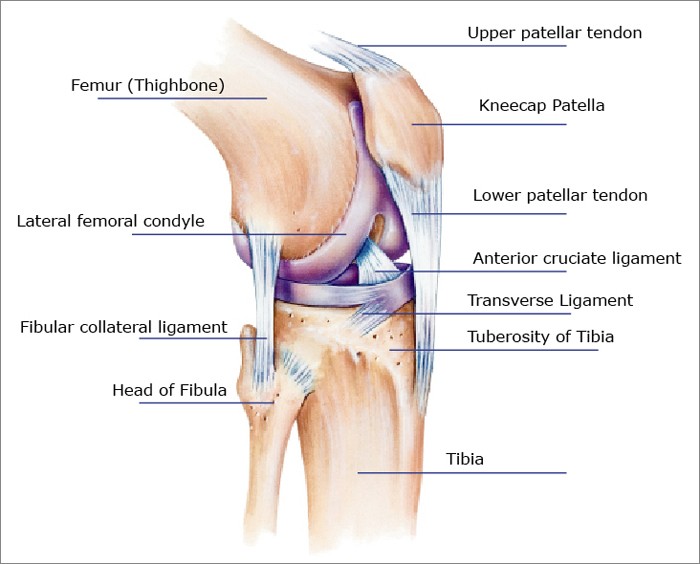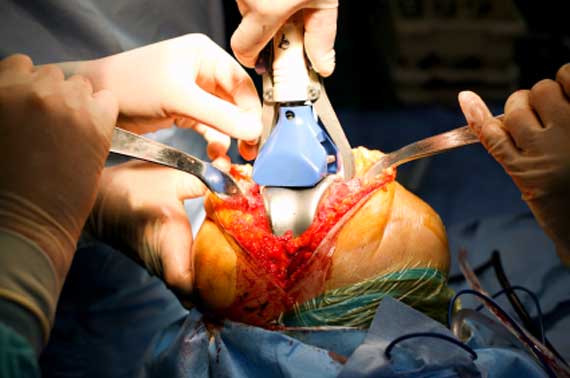Knee Pain: Symptoms, Causes, and Treatments
In addition to wear and tear on the knee, sports injuries are the source of many knee problems.
Symptoms
The most common symptom associated with a knee problem is pain. Pain can be dull, sharp, intermittent, or constant. Pain can also be mild to severe. In addition to pain, range of motion of the knee can be too much or too little. You may even hear grinding or popping. The muscles around the knee may even feel weak or the knee can lock. More detailed descriptions of knee symptoms follow:
- Pain and Tenderness: Knee pain is typically the most common bothersome symptom that people experience. Pain that is worse with activity may be due to arthritis or tendonitis. Pain and tenderness accompanied by swelling can be associated with a more serious injury such as ligament or meniscus tears or even a fracture.
- Swelling: Besides pain, one of the most common knee symptoms is localized swelling. Swelling can be the result of bleeding into the joint (hemarthrosis) from an injury or the result of too much joint fluid. The latter usually occurs when the joint is inflamed.
- Locking: Locking of the knee occurs when there is a mechanical block to motion within the knee (i.e. the knee feels stuck and can’t move). This is usually the result of a loose body or a torn meniscus within the knee. A loose body is typically a piece of cartilage, bone, or meniscus that is free-floating within the knee.
- Instability: There are many reasons why your knee may feel unstable. When your knee feels unstable it may feel like it suddenly gives way from time to time. Instability can be caused by weak leg muscles, a ligament injury, or even pain.
- Snaps, Crackles and Pops: It is quite common for the knee to snap, crackle, or pop. As long as the knee is painless, this is nothing to worry about. However, if you have associated pain, swelling, or loss of knee function, you should see an orthopedic surgeon. Finally, if a sudden injury is associated with a pop, this can indicate a more serious ligamentous injury.

Pathological Conditions and Syndromes in the Knee
- Osteoarthritis (Degenerative Arthritis) – Caused by aging and wear and tear of articular cartilage
- Infectious Arthritis
- Chondromalacia Patellae – Pain from irritation of the cartilage on the underside of the kneecap; a common cause of knee pain in young people.
- Osteochondritis Dissecans
- Gout – A form of arthritis caused by a buildup of uric acid crystals in a joint
- Plica Syndrome – caused by irritation of the inner lining of the knee joint
- Rheumatoid Arthritis – An autoimmune condition that can cause arthritis in any joint, including the knees. If untreated, rheumatoid arthritis can cause permanent joint damage.
Traumatic Knee Injuries
- Anterior cruciate ligament (ACL) Injury – The ACL plays a big role in the stability of the knee. An ACL tear often causes the knee to feel unstable and “give out” or buckle
- Meniscus tear
- Lateral and Medial Collateral Ligament Injury
- Posterior Cruciate Ligament (PCL) Injury
- Patellar Injuries
- Rupture of the Patellar Tendon
- Fracture and Stress Fracture
Repetitive Knee Injuries
- Patellofemoral Syndrome (Runner’s Knee)
- Tendonitis
- Bursitis (Housemaid’s Knee)
- Illiotibial Band Syndrome
- Osgood-Schlatter Disease
Some knee problems can be temporarily treated with rest, ice, or anti-inflammatory medications. Others will improve with physical therapy (knee rehab exercises) or knee injections. In some cases, surgery may be indicated.

